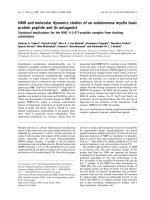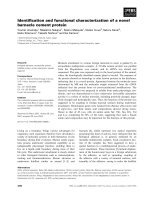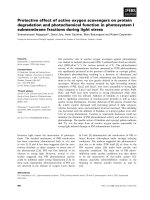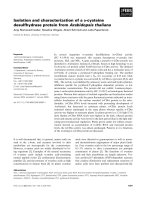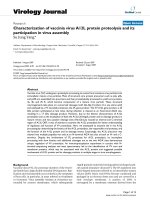Characterization of candida albicans cyclase associated protein CAP1 and its roles in morphogenesis g actin associates with the adenylyl cyclase cyr1 through cap1 and regulates cAMP synthesis in candida albicans hyphal morphogenesis
Bạn đang xem bản rút gọn của tài liệu. Xem và tải ngay bản đầy đủ của tài liệu tại đây (3.77 MB, 137 trang )
CHARACTERIZATION OF CANDIDA ALBICANS
CYCLASE-ASSOCIATED PROTEIN CAP1 AND ITS
ROLES IN MORPHOGENESIS
—
G-actin Assoicates with the Adenylyl Cyclase Cyr1 through Cap1 and
Regulates cAMP Synthesis in Candida albicans Hyphal Morphogenesis
ZOU HAO
NATIONAL UNIVERSITY OF SINGAPORE
2008
- i -
CHARACTERIZATION OF CANDIDA ALBICANS
CYCLASE-ASSOCIATED PROTEIN CAP1 AND ITS
ROLES IN MORPHOGENESIS
—
G-actin Assoicates with the Adenylyl Cyclase Cyr1 through Cap1
and Regulates cAMP Synthesis in Candida albicans Hyphal
Morphogenesis
ZOU HAO
A THESIS SUBMITTED
FOR THE DEGREE OF DOCTOR OF PHILOSOPHY
DEPARTMENT OF MICROBIOLOGY
NATIONAL UNIVERSITY OF SINGAPORE
2008
- ii -
ACKNOWLEDGEMENTS
First and foremost, my deepest gratitude goes to my supervisor, Dr. Yue
Wang (Associate Professor). His constant encouragement, insightful guidance and
stimulating discussions help me to walk all the way through the stages of research and
thesis-writing.
Second, I would like to express my sincere gratitude to members of my Ph.D.
supervisor committee, Associate Professor Mingjie Cai and Associate Professor
Edward Manser, for their constructive instructions and suggestions in improving my
research work through all these years.
I also owe my heartfelt gratitude to all the past and present members in YW
lab, in particular, Dr. Haoming Fang for his teaching me all the microbiological
techniques when I joined the lab, Dr. Chen Bai for his valuable suggestions on my
thesis-writing, and Ms. Yanming Wang for her friendship and high-standard technical
support.
Last, I am glad to extend my gratitude to my family including my parents, my
parents in law, my dear husband and my beloved son. It was really a laborious task to
accomplish a Ph.D. research, but your extensive supports made the whole process full
of pleasure.
Zou Hao
August 2008
- iii -
TABLE OF CONTENTS
ACKNOWLEDGEMENTS ii
TABLE OF CONTENTS iii
LIST OF FIGURES vii
LIST OF TABLES ix
ABBREVIATIONS x
SUMMARY xi
CHAPTER 1 Introduction 1
1.1 Pathogenesis of C. albicans 3
1.1.1 Candidiasis 3
1.1.2 Behaviors of C. albicans during infection 4
1.1.3 Host defense systems 6
1.2 Polymorphism of C. albicans 8
1.3 The Regulation of morphological transitions 9
1.3.1 The cAMP-dependent protein kinase A pathway 10
1.3.2 Other pathways involved in hyphal growth 12
1.3.3 Hypha-specific genes 15
1.3.4 Cell cycle inhibition and pseudohyphal growth 18
1.4 Polarity establishment 19
1.4.1 Actin 19
1.4.2 The Rho-GTPase Cdc42 and its regulation 20
1.4.3 Polarisome and Spitzenkörper 22
1.4.4 Early phosphorylation of the septin Cdc11 24
1.5 Cyclase-associated protein 1 (Cap1) 25
1.5.1 Evolutionary conservation of CAP proteins 25
1.5.2 The actin-regulatory function of Cap1 27
1.5.3 Regulation of adenylyl cyclase by Cap1 in fungi 29
1.6 Research objectives 30
CHAPTER 2 Materials and Methods 32
2.1 Reagents 32
- iv -
2.2 Strains and culture conditions 32
2.3 C. albicans and S. cerevisiae manipulations 34
2.3.1 Transformation 34
2.3.2 Preparation of C. albicans genomic DNA 34
2.3.3 Preparation of C. albicans RNA 35
2.3.4 Preparation of C. albicans total cell lysates 36
2.3.5 Yeast two-hybrid assay 37
2.4 Gene disruption and expression 37
2.4.1 C. albicans gene deletion 37
2.4.2 Construction of Cap1 domain-deletion mutants and
epitope-tagging of proteins 40
2.5 DNA work 41
2.5.1 Oligonucleotide primers and PCR 41
2.5.2 Recombinant DNA methods 41
2.5.3 Transformation of E. coli 42
2.5.4 Plasmid preparation and analysis 43
2.5.5 Preparation of DNA probes 44
2.6 RNA work 45
2.6.1 RT-PCR 45
2.6.2 Real time (RT) PCR 45
2.7 Protein work 46
2.7.1 Western blot analysis 46
2.7.2 Immunoprecipitation (IP) 47
2.7.3 Expression and purification of GST-fusion proteins 47
2.7.4 Actin depletion pull-down assays 48
2.8 Microscopy and fluorescence studies 49
2.8.1 Microscopy 49
2.8.2 Endocytosis assays 49
2.8.3 Actin staining by rhodamine-phalloidin 50
2.9 Adenylyl cyclase activity and cAMP assays 50
2.9.1 cAMP assay in vivo 50
2.9.2 Adenylyl cyclase activity assay in vitro 54
- v -
CHAPTER 3 Characterization of C. albicans Cap1 and its Function
in Morphogenesis 56
3.1 Introduction 56
3.2 Expressing Cap1 mutants in C. albicans 56
3.3 Interaction of Cap1 with actin and Cyr1 61
3.3.1 The C-terminal part of Cap1 binds ADP-G-actin in vitro. 61
3.3.2 The N-terminal part of Cap1 binds the adenylyl cyclase
Cyr1 in vitro. 62
3.3.3 Cyr1, Cap1 and actin form a complex in vivo. 63
3.4 Influence of Cap1 on the actin cytoskeleton 67
3.4.1 Subcellular locations of Cap1 67
3.4.2 Other effects of Cap1 on actin cytoskeleton 70
3.5 Role of Cap1 in Cyr1 activation 71
3.5.1 Cap1 N-terminal part is not sufficient for optimal control
of cellular cAMP levels during hyphal induction. 71
3.5.2 Cap1 C-terminal part is required for optimal cAMP
production during hyphal growth. 73
3.6 Effects of Cap1 mutants on cell morphology 75
3.6.1 Effects on yeast cells 75
3.6.2 Effects on Cap1 mutants on HU-induced filamentous growth 77
3.6.3 Effects on hyphal growth 78
3.7 Summary 82
CHAPTER 4 The Cellular Status of the Actin Cytoskeleton Affects the
cAMP Signaling Pathway through Cap1 84
4.1 Introduction 84
4.2 External cAMP alleviates the inhibitory effect of LatA on the
expression of HSGs 85
4.3 The effect of LatA on HSG expression partly depends on the
C-terminal part of Cap1 87
4.4 LatA and other actin-binding drugs affect cAMP production in
cell lysates 89
4.5 LatA and Cyto-A affect cAMP production in purified
Cyr1/Cap1/actin complex 92
- vi -
4.6 Investigations of how actin toxins affect Cyr1 activity through Cap1 94
4.7 Summary 97
CHAPTER 5 Discussions 99
5.1 G-actin plays an important role in regulating Cyr1 activity through Cap1 99
5.2 Repression of the cAMP pathway by actin depolymerizing toxins 101
5.3 The capacity of Cyr1/Cap1/actin ternary complex 104
5.4 The role of the cAMP spike during hyphal induction 105
5.5 Conclusion 106
REFERENCES 109
PUBLICATIONS 119
- vii -
List of Figures
Figure 1.1.3 A simplified view of T helper responses to C.
albicans
7
Figure 1.2.1 Different growth forms of C. albicans 9
Figure 1.3.1 Regulation of polymorphism in C. albicans by
multiple signaling pathways
13
Figure 1.5.1 Schematic description of Cap1 (C. albicans)
functional domains and conserved regions
26
Figure 3.2.1 Chromosomal deletion of CAP1 58-59
Figure 3.3.1 Cap1 binds ADP-actin monomers 62
Figure 3.3.2 Association of Cyr1 and Cap1 63
Figure 3.3.3 Cyr1, Cap1 and actin interactions in vivo 66
Figure 3.4.1 Cellular localizations of Cap1 69
Figure 3.4.2 Cap1 regulation of endocytosis 71
Figure 3.5.1 Increase of cellular cAMP levels during serum-
induced hyphal growth
72
Figure 3.5.2 Influence of Cap1 C-terminal part in Cyr1 activation 74-75
Figure 3.6.1 Effects of Cap1 mutants on yeast cells 76
Figure 3.6.2 Effects of CYR1 and CAP1 mutants on HU-induced
filamentous growth
78
Figure 3.6.3 Hyphal growth of Cap1 mutants under serum
induction
80
Figure 3.6.3.2 Hyphal growth of CAP1 mutants in RPMI medium,
Lee’s medium, Spider medium and embedding
conditions
81
Figure 4.2 Effect of LatA on the expression of HSGs and the
role of Cap1 in this process
86-87
Continue on next page
- viii -
Continue from previous page
Figure 4.3 Effect of LatA on the expression of HSGs in strains
expressing truncated Cap1
88-89
Figure 4.4 cAMP production in cell lysates 91
Figure 4.5 cAMP production by affinity-purified Cyr1-
containing complex in vitro
93
Figure 4.6 Investigation of how the actin toxins affect Cyr1
activity through Cap1
95-96
- ix -
LIST OF TABLES
Table 1.3.3 HSGs are involved in diverse cellular functions 16
Table 2.1 C. albicans strains used in this study 33
Table 2.2 Drugs and treatment conditions 33
Table 2.3 Oligonucleotide primers used in this study 38-39
- x -
ABBREVIATIONS
3k Serum 3 kDa filtrate
aa Amino acid
5-FOA 5-fluoro orotic acid
Ala (A) Alanine
ATP Adenosine-5'-triphosphate
bp Base pair or base pairs
BPS Bathophenanthroline sulfonate
cAMP 3'-5'-cyclic adenosine monophosphate
Cyto-A (CytoA) Cytochalasin A
DAPI 4',6-diamidino-2-phenylindole
DTT Dithiothreitol
EDTA Ethylenediamine tetraacetic acid
fmol Femtomolar
g Gram
GFP Green fluorescence protein
Gln (Q) Glutamine
Glu (E) Glutamic acid
HFM- 6×His-Flag-6×Myc tag
hr Hour
HSG Hypha-specific gene
HU Hydroxyurea
Continue on next page
- xi -
Continue from previous page
Jasp Jasplakinolide
Kb Kilo bases
kDa Kilo dalton
LatA (Lat-A) Latrunculin A
MAPK Mitogen-activated protein kinase
mCi Millicurie
mg Milligram
min Minute
ml Milliliter
ng Nanogram
OD Optical density
ORF Open reading frame
PAGE Polyacrylamide gel eletrophoresis
PBS Phosphate buffered saline
PCR Polymerase chain reaction
Pro (P) Proline
RT- Reverse transcription-
s Second
UV Ultraviolet
μl Microlitre
μM Micromolar
- xii -
SUMMARY
The yeast-to-hyphal growth switch is one of the most prominent biological
features and a key virulence trait of the human fungal pathogen Candida albicans.
This switch can be induced by a range of environmental signals and mediated by
multiple signaling pathways. Among these pathways, the cAMP/protein kinase A
(PKA) cascade has proved to be the most critical. In response to hyphal induction, an
essential cellular process for hyphal growth is the polarization of the actin
cytoskeleton toward the hyphal tips, responsible for transporting new cell materials to
the site of cell growth. In spite of the greart importance of the cAMP signaling
pathway and the actin cytoskeleton for hyphal growth, the molecular links between
them remain largely unknown. The aim of this study is to test a hypothesis that the
cyclase-associated protein Cap1, which has the capacity to interact with both actin
and the adenylyl cyclase Cyr1, may play an important role in linking the actin
cytoskeleton and the cAMP/PKA pathway.
In the main body of this thesis, Chapter 3 describes the characterization of
Cap1 in C. albicans (Ca). I first confirmed that CaCap1 indeed has a role in regulating
Cyr1 activation and certain aspects of the actin cytoskeleton, consistent with earlier
studies of its orthologue in Saccharomyces cerevisiae. I later found that in addition to
the N-terminal part that had previously been shown to bind to and activate Cyr1 in S.
cerevisiae, the G-actin binding site at the C-terminal end is also required for
producing the maximal level of cellular cAMP during hyphal growth. Interestingly,
although the C-terminal part of Cap1 cannot bind to Cyr1, it can activate Cyr1 when
fused to the C-terminal end of Cyr1. The results indicate that the N- and C-terminal
parts of Cap1 activate Cyr1 by different mechanisms. By conducting a series of
immunoprecipitation experiments using cells expressing various truncated versions of
- xiii -
Cap1, I obtained strong evidence that Cyr1, Cap1 and G-actin form a ternary complex
in which Cap1 acts as a bridge. Based on the results above, I hypothesize that G-actin
may regulate Cyr1 activity through its interaction with Cap1, thereby providing a
mechanistic link between the cellular actin status and the cAMP signaling pathway.
Chapter 4 presents functional studies of Cap1 and actin in regulating the
adenylyl cyclase activity of Cyr1 both in vitro and in vivo. First, I demonstrated that a
protein complex containning Cyr1, Cap1 and actin can be purified and is sufficient for
producing cAMP in vitro under hyphal-inducing conditions. In comparison, the
complex containing a Cap1 mutant deleted of the G-actin binding site at the C-
terminal end exhibited markedly reduced ability of cAMP synthesis. Consistently,
cells expressing this Cap1 mutant produced a much delayed and lower peak of cAMP
in response to hyphal induction as well as defective hyphal morphology. Using the
purified Cyr1/Cap1/actin complex, I found that the actin depolymerization drugs
Latrunculin A (LatA) and cytochalasin A (Cyto-A) could also inhibit Cyr1 activity
and this inhibition depends on the presence of the G-actin binding site of Cap1,
providing further evidence for a direct role of G-actin in regulating Cyr1 activity. The
results explain the previous intriguing observation that LatA causes poor response in
the expression of hypha-specific genes. Coimmunoprecipitation experiments showed
that the drugs did not cause dissociation of actin from the Cyr1/Cap1/actin complex.
Thus, I propose that the actin depolymerizing drugs act by causing conformational
changes of the ternary complex resulting in impaired response to the hyphal-inducing
signals. Furthermore, the finding that the purified Cyr1/Cap1/actin complex can
increase cAMP synthesis in response to hyphal-inducing molecules indicates that the
complex is essentially an intact sensor/effector module for activated cAMP synthesis.
- xiv -
In Chapter 5, I propose a model on how Cap1 and actin regulate Cyr1 activity
during C. albcians hyphal growth. The results of this study for the first time
demonstrate that G-actin plays an active role in directly regulating cAMP synthesis by
forming a ternary complex with Cyr1 and Cap1, revealing a mechanistic link for the
regulation of the cAMP/PKA pathway by the status of the cellular actin cytoskeleton.
The purified Cyr1/Cap1/actin complex can serve as a useful model for further studies
of signal sensing and the activation of the cyclase in response to other molecules
known to cause changes in cellular cAMP levels.
Chapter1 Introduction
1
CHAPTER 1
Introduction
Candida albicans is an opportunistic human fungal pathogen that has received
an increasing amount of interest in both clinical medicine and fundamental biology.
Usually, C. albicans is a member of the normal microbial flora colonizing human
gastrointestinal and vaginal tracts (Odds, 1988). In healthy human hosts, it may only
cause a range of mild superficial infections (Richardson, 1991). But in
immunocompromised patients, life-threatening systemic candidiasis may develop
(Rabkin et al., 2000; Richards et al., 1999). In recent years, candidiasis has become
more and more severe due to the rapid global spread of AIDS and the wide use of
powerful antibiotics and immune-suppressive therapies during organ transplant or
anti-leukemia therapies (Ruhnke, 2004). To make the situation worse, treatment of
candidiasis is difficult due to the limited choices of anti-C. albicans drugs.
Furthermore, drug-resistant strains have been found all over the world (Boken et al.,
1993; Odds, 1993; Sanglard et al., 1995). Thus, in order to better control this life-
threatening disease, it is urgent to understand the biological processes of C. albicans
relevant to infection.
Besides its medical significance, C. albicans is also an important model for
studying some fundamental biological issues. Researchers have been aware of its
dynamic genome as well as its unusual sexual cycle (Hull et al., 2000; Magee and
Magee, 2000; Perepnikhatka et al., 1999). More importantly, C. albicans has the
ability to grow in different morphologies such as yeast, hyphae and pseudohyphae
(polymorphism) in response to different environmental stimuli. All these
morphologies have importance in virulence, and proper transitions between them have
been shown to be essential for infection and virulence (Mitchell, 1998). To control
Chapter1 Introduction
2
these transitions properly, C. albicans uses multiple biological processes, some of
which are conserved for morphological transitions in higher eukaryotes. Thus,
elucidating the mechanisms underlying C. albicans morphological transitions will
undoubtedly contribute to a greater appreciation of fungal pathogenesis and virulence
as well as the understanding of cell morphogenesis, polarity control and cell-cycle
regulation.
To date, several key events of C. albicans morphological transition have been
discovered, including the phosphorylation of the septin Cdc11 in the early stage of
hyphal devlopment (Sinha et al., 2007), the transcriptional upregulation of hypha-
specific genes (HSGs) by signaling pathways (Berman and Sudbery, 2002; Bockmuhl
et al., 2001; Brown and Gow, 1999; Liu, 2001; Sonneborn et al., 2000; Stoldt et al.,
1997; Whiteway and Oberholzer, 2004), and the conserved polarization of the actin
cytoskeleton and its regulators (Hazan and Liu, 2002; Li et al., 2005). All these events
have to be precisely coordinated for a successful morphological transition. To achieve
the coordination, it is important to have regulatory links between different processes.
However, these links are poorly understood in most cases.
This study is focused on the identification and characterization of molecular
links between the cAMP/PKA pathway and the actin cytoskeleton. The thesis will
describe the study of the cyclase-associated protein Cap1, which had previously been
shown to interact with both actin and the adenlyly cyclase Cyr1. In the following
introduction section, I will review the pathogenesis of C. albicans and the response of
the host defense systems during infection, current understanding of different
processes of its morphological transition, and previous studies on Cap1.
Chapter1 Introduction
3
1.1 Pathogenesis of C. albicans
1.1.1 Candidiasis
C. albicans and other Candida spp. are frequently isolated from various
mucosal sites such as gastrointestinal and vulvovaginal tracts, but few cases develop
into clinical diseases. The integral host tissues and the intact immune system maintain
a commensal relationship between C. albicans and host (Calderone, 2001). It is
believed that host environmental changes trigger fungal proliferation and thus lead to
infection (Edwards, 1996). Clinically, candidiasis can be classified into superficial
infections and deep infections. Superficial infections include the cutaneous
candidiasis and two types of mucosal infections: gastrointestinal candidiasis and
vaginal candidiasis. Deep infections are also called invasive candidiasis, which may
happen in deep organs or as hematogenously disseminated infections (blood stream
candidiasis).
Cutaneous candidiasis occurs on skin or nails. Acute cutaneous candidiasis
may produce intense erythema, edema, creamy exudates and satellite pustules on the
skin (Erbagci, 2004). It most frequently occurs in warm, moist conditions such as
under diapers of newborns, in skin folds and in tropical climates. It is the only type of
candidiasis that happens in healthy human hosts (Kirkpatrick et al., 1971).
Patients with impaired epithelial surfaces (trauma burns and even after surgery)
or reduced resident bacteria (treated with broad-spectrum antibiotics) are inclined to
get mucosal candidiasis (Rolstad and Erwin-Toth, 2004). In this situation, C. albicans
is shown to migrate across an intact gastrointestinal or vaginal lumen. The activation
of phospholipases and proteinases confers C. albicans the ability to adhere and invade
the damaged epithelial surfaces (Mavor et al., 2005).
Chapter1 Introduction
4
When C. albicans penetrates the mucosal surfaces and disseminates through
the circulation system, it causes invasive candidiasis. Risks of this disease include
extremes of age, immunosuppression (AIDS or cancer patients) (Kasper and Buzoni-
Gatel, 1998), malignancy with leucopenia, major abdominal surgery, trauma,
exposure to multiple antibacterial agents, central venous catheterization, prolonged
period of stay in intensive care units, and poor nutrition.
Invasive candidiasis is life-threatening but its treatment is difficult. C. albicans
generates strong drug resistances against the traditional antifungal agents such as
amphorestericin B, azoles and 5-fluorocytosine (St Georgiev, 2000). One possible
alternative treatment is to improve immunity of the immunocompromised host,
including the usage of cytokines, chemokines and growth factors. In experimental
conditions, they are proved to be beneficial. However, in clinical practice, they are
less effective. It may be due to that an individual alteration is not enough to affect the
whole immune system. Another alternative treatment is specific immunoprotection.
Some vaccines are generated, for example antibodies inhibiting morphogenesis of C.
albicans. However, their clinical values are still under investigation (De Pauw, 2001).
1.1.2 Behaviors of C. albicans during infection
Forming biofilms and penetrating cellular surfaces for invasion are two
important virulence determinants during candidiasis. Both events need the
polymorphism of C. albicans. Biofilms are defined as “structured microbial
communities that are attached to a surface and encased in a matrix of exopolymeric
material” (Ramage et al., 2002). C. albicans biofilms exist on host surfaces of oral
cavity, esophagus and heart valves. They also exist on implanted biomaterials such as
pacemakers, stents and catheters. The biofilms cause infections and increase C.
Chapter1 Introduction
5
albicans resistance to antifungals (d'Enfert, 2006). The formation of biofilms include
yeast-form cells adhering to a surface by hydrophobic and electrostatic interactions in
early stages, followed by hyphal formation, expression of adhesin genes and secretion
of extracellular materials. After 24 to 48 hr of development the fully matured biofilms
consist of a dense network of yeast cells, hyphae, pseudohyphae and extracellular
polymeric materials (Hawser and Douglas, 1994). The yeast-to-hyphal transition is
critical for biofilm formation. Deletion of the transcription factor gene EFG1 or
CPH1 impairs the formation of filamentous cells and results in rather pool biofilms
(Lopez-Ribot, 2005).
Biofilms cause local infections. To cause invasive candidiasis, C. albicans
cells need to penetrate both mucosal surfaces and blood vessel epithelial cells (Gow et
al., 2003; Malic et al., 2007). There are two kinds of mechanisms for C. albicans to
penetrate mucosal surface. One is to generate proteins anchoring to and digesting the
surface of epithelial cells. For example, Hwp1, a hypha-specific wall protein which
helps anchoring cells onto the host epithelium (Staab et al., 1999), and SAPs, a group
of secreted proteolytic enzymes which digest the epithelial surface (Naglik et al.,
2004). Another mechanism is to induce endocytosis of epithelial cells. Being induced
by C. albicans, epithelial cells produce pseudopods to surround C. albicans cells and
pull them across epithelial cells to enter blood stream (Rittig et al., 1998). The ability
of endocytosis induction is related to C. albicans hyphal form: since this ability is
compromised significantly in cells that fail to form hyphae (Henriques et al., 2007).
Crossing endothelial cells of blood vessels is similar to the penetration of
mucosal surfaces, but the endocytosis favorite pathway is different in different
vascular beds. For example, hyphae are easily taken up by umbical vein endothelial
cells (Zink et al., 1996), but yeast form cells are easy to be taken into porcine and
Chapter1 Introduction
6
brain microvascular endothelial cells (Jong et al., 2003). In organs with fenestrated
blood vessels like kidney, C. albicans can directly pass through between endothelial
cells. This makes kidney one of the most easily invaded organs by C. albicans
(Raghavan et al., 1987). Leukocytes can phagocytose C. albicans, but cannot kill it,
thus make it possible to cross the endothelial cell barrier through the migration of
leukocytes (Olver et al., 2006).
Since all these processes are relevant to the polymorphism of C. albicans,
researches in morphogenesis are important for the eventual control of infections by
this organism.
1.1.3 Host defense systems
The host defense systems against C. albicans can be divided into nonspecific
and specific immune systems. The former includes the formation of keratinized cells,
the antifungal lipids from sebaceous glands, and calprotectin (leucocyte protein L1)
(Brandtzaeg et al., 1995). The latter normally indicates the innate immunity and
phagocyte-dependent immunity (Mencacci et al., 1999).
Innate immunity and acquired cell-mediated immunity have been
acknowledged as the primary mediators of host resistance to C. albicans (Fig 1.1.3).
The innate immune system discriminates between different forms of the fungus and
produces sets of cytokines and costimulatory molecules that signal the adaptive T
helper (Th) immunity. Upon recognition of Candida yeast cells, dendritic cells 1
(DC1) and polymorphonuclear neutrophils (PMN) produce IL-12 that is required for
the activation of T help 1 cells (Th1) producing IFN-r and IL-2, which stimulate
phagocytes to a fungicidal state. In contrast, upon interaction with C. albicans hyphae,
dendritic cells 2 (DC2) produces IL-4, which is required for the activation of T help 2
Chapter1 Introduction
7
cells (Th2) producing IL-4 and IL-10, both deactivating phagocytes. Meanwhile,
production of IL-10 by PMN further contributes to the inhibition of Th1 development.
This difference shows the importance of hyphae in C. albicans virulence (Romani et
al., 1997; Wormley et al., 2001)
Figure 1.1.3 A simplified view of T helper responses to C. albicans
Cells and their functions involved in the phagocyte-dependent immune
resistance to C. albicans are (d'Ostiani et al., 2000; Fidel et al., 1993):
• monocyte/macrophage: phagocytosis, killing, release of chemokines and
cytokines
• neutrophil: phagocytosis, killing, release of chemokines and cytokines,
costimulation
• endothelial cell: killing, release of chemokines and cytokines
• dendritic cell: phagocytosis, killing, release of cytokines, antigen presentation
Chapter1 Introduction
8
• lymphocyte: cytotoxic activity, release of cytokines
In immunosuppressed patients, the host immune systems cannot protect
patients from candidiasis. It has been shown that C. albicans could escape from the
macrophage entrapment by rapid yeast-to-hypha transition (Shin et al., 2005). Now
Candida spp. rank fourth among microbes most frequently isolated from blood
cultures of hospitalized patients (Yong et al., 2008).
1.2 Polymorphism of C. albicans
Polymorphism is important in C albicans invasion of the host. The ability to
switch between different morphologies is widely accepted to be necessary for
virulence. An objective measure of C. albicans cell morphology was developed by
Merson-Davies and Odds (Merson-Davies and Odds, 1989). The measurement is
based on three cellular dimensions: the length (l), the maximum diameter (d) and the
diameter at the septal junctions (s). The equation is ls/d
2
. For ovoid and unicellular
yeast cells, the index is around 1.0-1.5. For elongated pseudohyphal cells, it is usually
2.5 to 3.4. In pseudohyphae, the degrees of cell elongation may vary, while the septal
constrictions are always seen between individual cellular compartments. Hyphae are
tubular structures without septal constrictions and the cell morphology index is over
3.4 (Fig 1.2.1).
Chapter1 Introduction
9
Figure 1.2.1 Different growth forms of C. albicans
Morphological changes between the yeast and the various filamentous forms
occur in response to alternations in growth conditions. As shown in Fig 1.2.1, a wide
variety of parameters have been found to affect the morphology of C. albicans
(Berman and Sudbery, 2002). Some of the parameters reflect host internal body
conditions, for example, 37°C, serum and HCO
3
-
. In laboratories, the in vivo
conditions are often mimicked for induction experiments. For example, the
embedding condition mimics the hypoxia condition, and serum mimics the blood
stream condition. A combination of conditions may be required to activate hyphal
development. For example, serum alone is not sufficient to stimulate hyphal
development if the temperature is below 34
o
C (Biswas et al., 2007). However, how
these inducing signals finally lead to the establishment of the polarized growth is still
under investigation.
1.3 The regulation of morphological transitions
Several signal transduction pathways are responsible for relaying the hypha-
inducing signals to cellular machineries that execute the morphological switch, such
as the well-known cAMP/PKA pathway. Downstream of these pathways are the
Chapter1 Introduction
10
transcription of hypha-specific genes (HSGs), whose functions are highly diverse
including cell cycle regulation, invasion of substrates and adhesion to host cells.
Though the yeast-to-hypha switch is cell-cycle independent, inhibition of cell cycle
progression can induce pseudohyphal growth, which is mediated by distinct signal
transduction pathway than the hyphal growth.
1.3.1 The cAMP-dependent protein kinase A pathway
cAMP signaling is involved in many cellular functions including growth,
metabolism and morphogenesis. In C. albicans, it is considered to be the most
important signal transduction pathway involved in the yeast-to-hypha growth
transition. An increase of cytoplasmic cAMP occurs prior to hyphal emergence and
inhibiting the cAMP generation machine causes defects in almost all hyphal growth
conditions examined so far (Liu, 2002).
The core component in this pathway is the cAMP generator: a complex of
Cyr1 and Cap1. CYR1 (also known as CDC35) is the only adenylyl cyclase gene in C.
albicans (Mallet et al., 2000). It belongs to the class III adenylyl cyclases. The cyclase
homology domain (CHD) is located near the C terminus and the catalysis function
requires Cap1, which will be introduced later in this thesis. Near the protein’s N-
terminus there is a Ras-association (RA) domain, which is important for Ras1 binding
and hyphal induction (Fang and Wang, 2006). Cyr1 is activated upon hyphal
induction. After 30 min of serum induction, the intracellular cAMP level can reach a
peak level that is ~2-3 fold higher than that in uninduced cells. Deletion of CYR1
blocks hyphal growth in all conditions tested (Jain et al., 2003).
Upstream of the core cAMP generator is Ras1, the only Ras homologue in C.
albicans which is classically considered as an activator of Cyr1. RAS1-deletion strains


